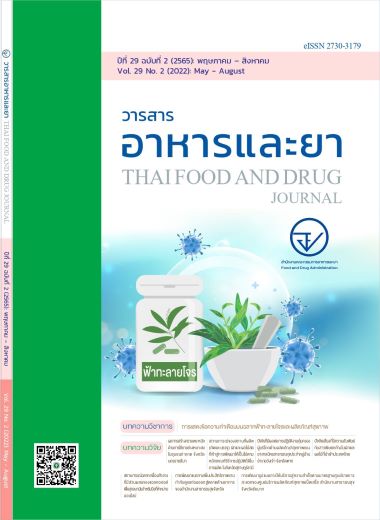ปัจจัยเสี่ยงที่มีความสัมพันธ์กับสารพิษตกค้างในผักและผลไม้ที่นำเข้าประเทศไทย
Main Article Content
บทคัดย่อ
ความสำคัญ: ในปี พ.ศ. 2562 ประเทศไทยนำเข้าผักและผลไม้มากกว่า 1 ล้านตัน ซึ่งสำนักงานคณะกรรมการอาหารและยาได้ตรวจสอบเฝ้าระวังสารพิษตกค้างในผักและผลไม้นำเข้า ณ ด่านอาหารและยาทั่วประเทศอย่างเป็นระบบ แต่ยังไม่เคยประเมินปัจจัยเสี่ยงที่สัมพันธ์กับการพบสารพิษตกค้าง
วัตถุประสงค์: เพื่อวิเคราะห์สถานการณ์การเฝ้าระวังสารพิษตกค้าง และประเมินปัจจัยเสี่ยงที่สัมพันธ์กับการพบสารพิษตกค้างในผักและผลไม้ที่นำเข้าประเทศไทย
วิธีการวิจัย: เป็นการศึกษาภาคตัดขวางแบบย้อนหลังของรายงานผลการวิเคราะห์สารพิษตกค้างด้วยวิธีทางห้องปฏิบัติการในผักและผลไม้นำเข้า ณ ด่านอาหารและยา ในภาคเหนือ กลาง และใต้ ระหว่างปีงบประมาณ พ.ศ. 2561 - 2562 เพื่อวิเคราะห์ความสัมพันธ์โดยใช้สถิติเชิงอนุมาน Chi-square test หรือ Fisher’s exact test ที่ระดับนัยสำคัญ p-value เท่ากับ 0.05
ผลการศึกษา: จากข้อมูลผักและผลไม้นำเข้าที่เก็บตัวอย่างจำนวน 1,375 ตัวอย่าง พบว่าไตรมาสที่ 1 (ตุลาคม – ธันวาคม) เป็นช่วงเวลาที่พบตัวอย่างตกมาตรฐานมากที่สุด และน้อยที่สุดในไตรมาสที่ 2 ที่ร้อยละ 20.56 และ 6.23 กลุ่มประเทศผู้ผลิต/จำหน่ายที่พบตกมาตรฐานมากที่สุด ได้แก่ ทวีปเอเชีย ร้อยละ 19.20 รองลงมาเป็นทวีปอเมริกาเหนือ และทวีปออสเตรเลีย ร้อยละ 8.54 และ 4.98 เมื่อพิจารณาถึงผู้ผลิต/จำหน่ายที่มีประวัติผักและผลไม้ตกมาตรฐานกับผู้มีประวัติผ่านมาตรฐาน พบว่ามีสัดส่วนตกมาตรฐาน ร้อยละ 33.20 และ 11.76 ส่วนผู้นำเข้าที่มีประวัติผักและผลไม้ตกมาตรฐานกับผู้มีประวัติผ่านมาตรฐาน พบว่ามีสัดส่วนใกล้เคียงกันที่ร้อยละ 14.40 และ 16.49 ภาพรวมของผักพบตกมาตรฐานร้อยละ 20.06 ชนิดของผักที่พบมากที่สุด 3 อันดับแรก ได้แก่ ผักบริโภคผลนอกเหนือจากตระกูลแตง ผักที่บริโภคลำต้นและก้าน และผักใบ ร้อยละ 65.71, 63.16 และ 49.33 ส่วนภาพรวมผลไม้พบตกมาตรฐาน ร้อยละ 10.58 โดย 3 อันดับแรก ได้แก่ ผลไม้ผลเดี่ยวที่มีเมล็ดแข็ง ผลไม้ตระกูลส้ม และเบอร์รีและผลไม้ผลเล็ก พบร้อยละ 36.36, 23.39 และ 15.79 ชนิดของสารพิษตกค้างที่พบในผักได้แก่ ออร์กาโนฟอสเฟต ไพรีทรอยด์ คาร์บาเมต และออร์กาโนคลอรีน ร้อยละ 15.35, 14.42, 13.95 และ 3.72 ขณะที่ในผลไม้พบร้อยละ 33.67, 17.35, 32.65, และ 2.04 นอกจากนี้ปัจจัยเสี่ยงที่มีความสัมพันธ์กับการพบสารพิษตกค้างในผักและผลไม้ที่นำเข้าในปริมาณที่ตกมาตรฐาน ได้แก่ ช่วงเวลานำเข้า ชนิดของผักและผลไม้ ประเทศผู้ผลิต/จำหน่าย และประวัติของผู้ผลิต/จำหน่าย ที่ p-value 0.000 แต่ไม่พบความสัมพันธ์กับประวัติผู้นำเข้า
สรุป: การนำเข้าผักและผลไม้พบสารพิษตกค้างมากที่สุดในไตรมาสที่ 1 (ตุลาคม – ธันวาคม) ภาพรวมพบผักตกมาตรฐานมากกว่าผลไม้ประมาณหนึ่งเท่า ประเทศในทวีปเอเชียตกมาตรฐานมากกว่ากลุ่มอื่น พบผู้ผลิต/จำหน่ายที่มีประวัติตกมาตรฐานมีสัดส่วนการตกมาตรฐานมากกว่ากลุ่มไม่มีประวัติเกือบสามเท่า นอกจากนั้นประเทศผู้ผลิต/จำหน่าย และประวัติของผู้ผลิต/จำหน่ายผักและผลไม้ เป็นปัจจัยเสี่ยงที่มีความสัมพันธ์กับการพบสารพิษตกค้างในผักและผลไม้นำเข้า
Article Details

อนุญาตภายใต้เงื่อนไข Creative Commons Attribution 4.0 International License.
เอกสารอ้างอิง
ลีณา สุนทรสุข. การลดสารตกค้างในผักและผลไม้ [อินเทอร์เน็ต]. กรุงเทพฯ: ภาควิชาเภสัชเคมี คณะเภสัชศาสตร์ มหาวิทยาลัยมหิดล; 2562 [เข้าถึงเมื่อ 25 ก.พ. 2563]. เข้าถึงได้จาก: https://www.pharmacy.mahidol.ac.th/knowledge/files/0452.pdf
Medina-Pastor P, Triacchini G. The 2018 European Union report on pesticide residues in food. EFSA Journal 2020;18(4):6057. doi: 10.2903/j.efsa.2020.6057.
Agricultural Marketing Service. Pesticide data program annual summary, calendar year 2020 [Internet]. Washington DC: U.S. Department of Agriculture; 2022 [cited 2022 Jan 17]. Available from: https://www.ams.usda.gov/sites/default/files/media/2020PDPAnnualSummary.pdf
เครือข่ายเตือนภัยสารเคมีกำจัดศัตรูพืช. ผลการเฝ้าระวังสารเคมีกำจัดศัตรูพืชตกค้างในผักและผลไม้ ประจำปี 2559 [อินเทอร์เน็ต]. กรุงเทพฯ: เครือข่ายเตือนภัยสารเคมีกำจัดศัตรูพืช; 2559 [เข้าถึงเมื่อ 25 ก.พ. 2563]. เข้าถึงได้จาก: https://www.thaipan.org/wp-content/uploads/2018/10/pesticide_doc24_press_4_5_2559.pdf
เครือข่ายเตือนภัยสารเคมีกำจัดศัตรูพืช. รายงานผลการสุ่มตรวจสารพิษตกค้างในผักผลไม้ ครั้งที่ 2/2559 [อินเทอร์เน็ต]. กรุงเทพฯ: เครือข่ายเตือนภัยสารเคมีกำจัดศัตรูพืช; 2559 [เข้าถึงเมื่อ 25 ก.พ. 2563]. เข้าถึงได้จาก: https://www.thaipan.org/wp-content/uploads/2018/10/pesticide_doc30.pdf
เครือข่ายเตือนภัยสารเคมีกำจัดศัตรูพืช. ไทยแพนแถลงข่าวมากกว่าครึ่งผักผลไม้มีสารกำจัดวัชพืชตกค้างเกินค่ามาตรฐาน [อินเทอร์เน็ต]. กรุงเทพฯ: เครือข่ายเตือนภัยสารเคมีกำจัดศัตรูพืช; 2560 [เข้าถึงเมื่อ 25 ก.พ. 2563]. เข้าถึงได้จาก: https://www.thaipan.org/action/513
เครือข่ายเตือนภัยสารเคมีกำจัดศัตรูพืช. ไทยแพนเปิดผลตรวจผักผลไม้พบสารพิษตกค้างเกินมาตรฐาน 41% ผักห้างแย่กว่าผักตลาดสด ตะลึงพบสารพิษห้ามใช้ในประเทศไทยตกค้างอื้อ 12 ชนิด [อินเทอร์เน็ต]. กรุงเทพฯ: เครือข่ายเตือนภัยสารเคมีกำจัดศัตรูพืช; 2562 [เข้าถึงเมื่อ 25 ก.พ. 2563]. เข้าถึงได้จาก: https://thaipan.org/wp-content/uploads/2019/pesticide_doc58.pdf
กรมศุลกากร. รายงานสถิตินำเข้า [อินเทอร์เน็ต]. กรุงเทพฯ: ศูนย์เทคโนโลยีสารสนเทศและการสื่อสาร กรมศุลกากร; 2563 [เข้าถึงเมื่อ 23 เม.ย. 2563]. เข้าถึงได้จาก: http://www.customs.go.th/statistic_report.php?show_search=1
กระทรวงสาธารณสุข. ระเบียบกรมวิทยาศาสตร์การแพทย์ว่าด้วยอัตราค่าบำรุงการตรวจวิเคราะห์และให้บริการ พ.ศ. 2562. ราชกิจจานุเบกษา ฉบับประกาศทั่วไป เล่มที่ 136, ตอนพิเศษ 130 ง (ลงวันที่ 22 พฤษภาคม 2562).
กองด่านอาหารและยา. ฐานข้อมูลการเฝ้าระวังกองด่านอาหารและยา [Database]. นนทบุรี.
กระทรวงเกษตรและสหกรณ์. ประกาศกระทรวงเกษตรและสหกรณ์ เรื่อง กำหนดมาตรฐานสินค้าเกษตร : การจัดกลุ่มสินค้าเกษตร : พืช ตามพระราชบัญญัติมาตรฐานสินค้าเกษตร พ.ศ. 2551. ราชกิจจานุเบกษา ฉบับประกาศ ทั่วไป เล่มที่ 133, ตอนพิเศษ 264 ง (ลงวันที่ 18 พฤศจิกายน 2559).
กระทรวงสาธารณสุข. ประกาศกระทรวงสาธารณสุข เลขที่ 387 พ.ศ. 2560 เรื่อง อาหารที่มีสารพิษตกค้าง. ราชกิจจานุเบกษา ฉบับประกาศ ทั่วไป เล่มที่ 134, ตอนพิเศษ 228 ง (ลงวันที่ 18 สิงหาคม 2560).
กระทรวงสาธารณสุข. ประกาศกระทรวงสาธารณสุข ฉบับที่ 393 (พ.ศ. 2561) ออกตามความในพระราชบัญญัติอาหาร พ.ศ. 2522 เรื่อง อาหารที่มีสารพิษตกค้าง (ฉบับที่ 2). ราชกิจจานุเบกษา ฉบับประกาศ ทั่วไป เล่มที่ 135, ตอนพิเศษ 264 ง (ลงวันที่ 24 กันยายน 2561).
บงกช โอฬารรัตน์มณี. การพัฒนาแนวทางการเก็บตัวอย่างผลิตภัณฑ์นำเข้า กรณีศึกษาผลไม้สดนำเข้า [วิทยานิพนธ์ปริญญาเภสัชศาสตรมหาบัณฑิต]. นครปฐม: มหาวิทยาลัยศิลปากร; 2556.
อมรินทร์ นันทวิทยาภรณ์. การศึกษาสถานการณ์ กฎหมาย และการควบคุมสารพิษตกค้างในผักสดและผลไม้สดนำเข้าจากต่างประเทศ. วารสารอาหารและยา 2555;19(3):36-45.
ตรีวิทย์ เพ็ญสว่างวัธน์. การศึกษาปัจจัยที่ส่งผลต่อการจำแนกความเสี่ยงของผักและผลไม้สดที่นำเข้าโดยใช้แบบจำลองการจำแนกกลุ่ม [วิทยานิพนธ์ปริญญาเภสัชศาสตรมหาบัณฑิต]. กรุงเทพฯ: มหาวิทยาลัยเกษตรศาสตร์; 2561.
พรพรรรณ อนุศาสนี, ชนิพรรณ บุตรยี่, ปรัญรัชต์ ธนวิยุทธ์ภัคดี, วีรยา การพานิช. การประเมินความเสี่ยงการได้รับสารป้องกันกำจัดศัตรูพืชกลุ่มคาร์บาเมตจากการบริโภคผักผลไม้ของประชากรไทย. วารสารพิษวิทยาไทย 2564;36(1):91-112.


